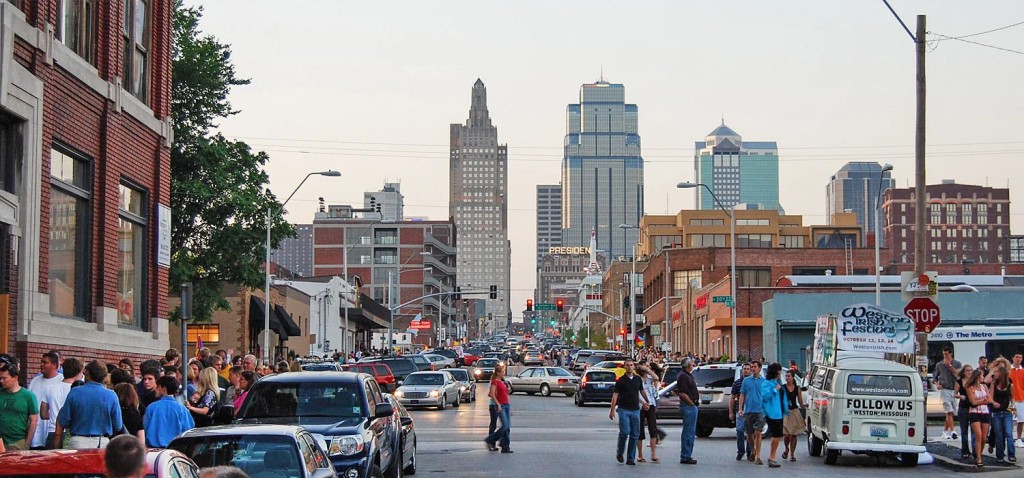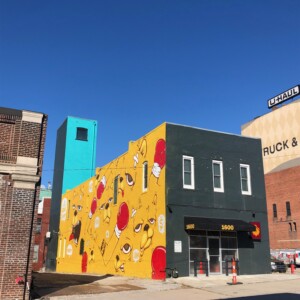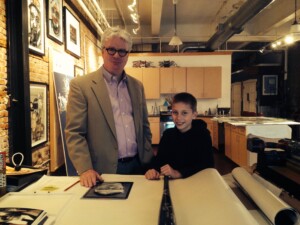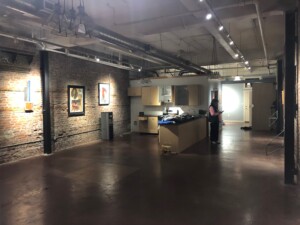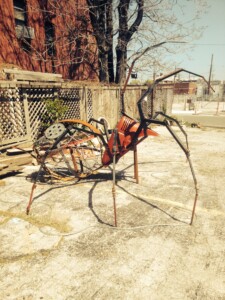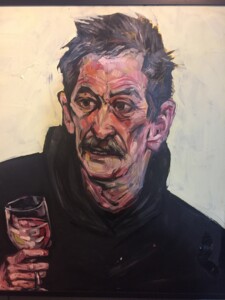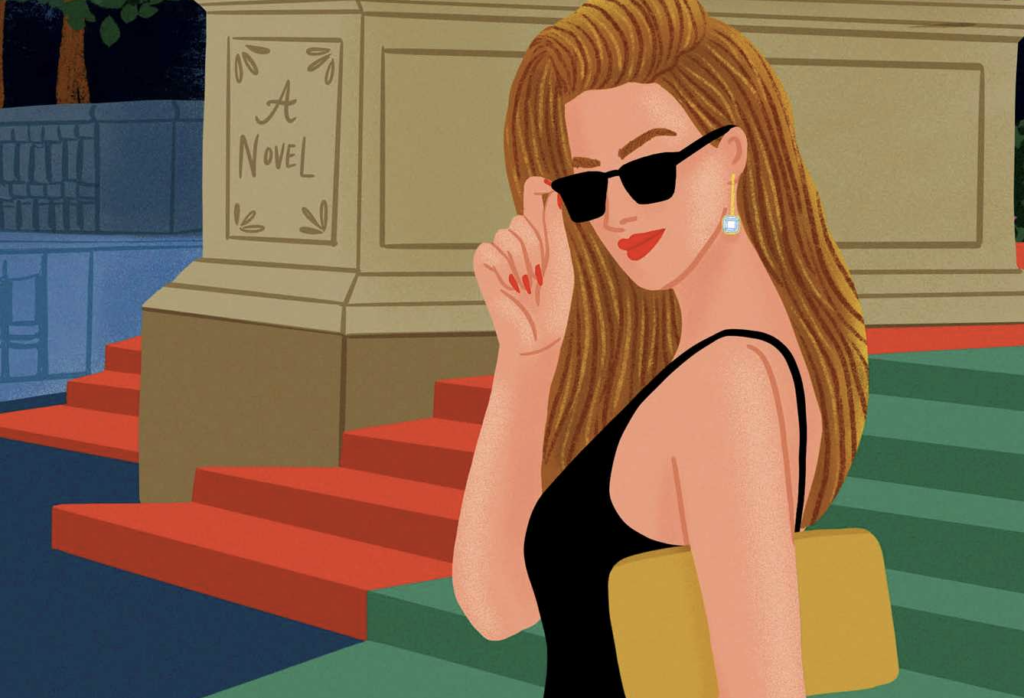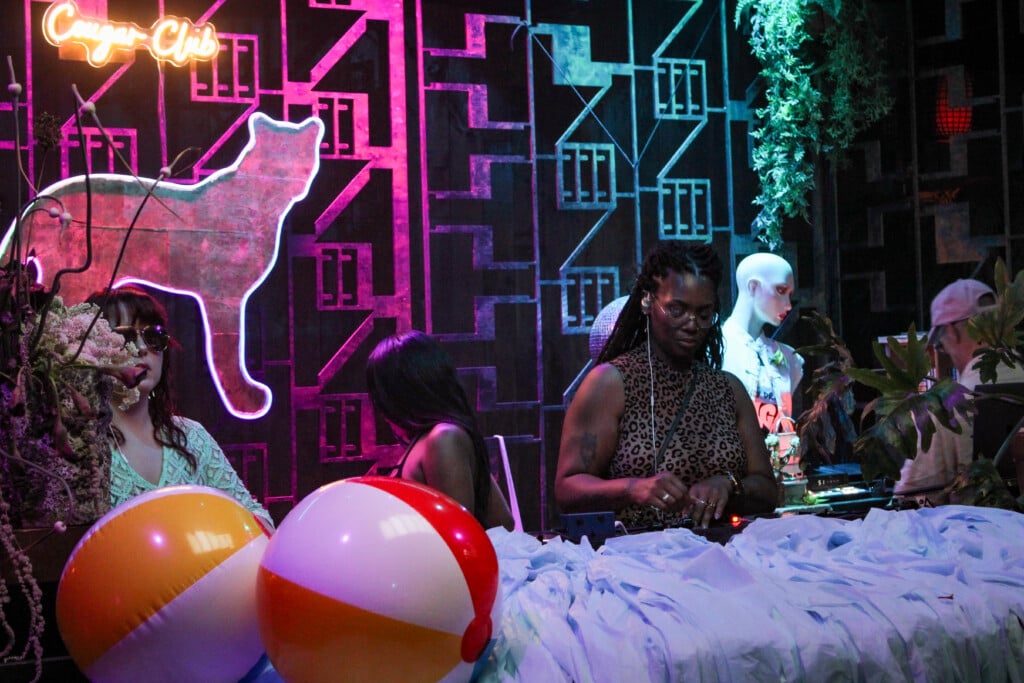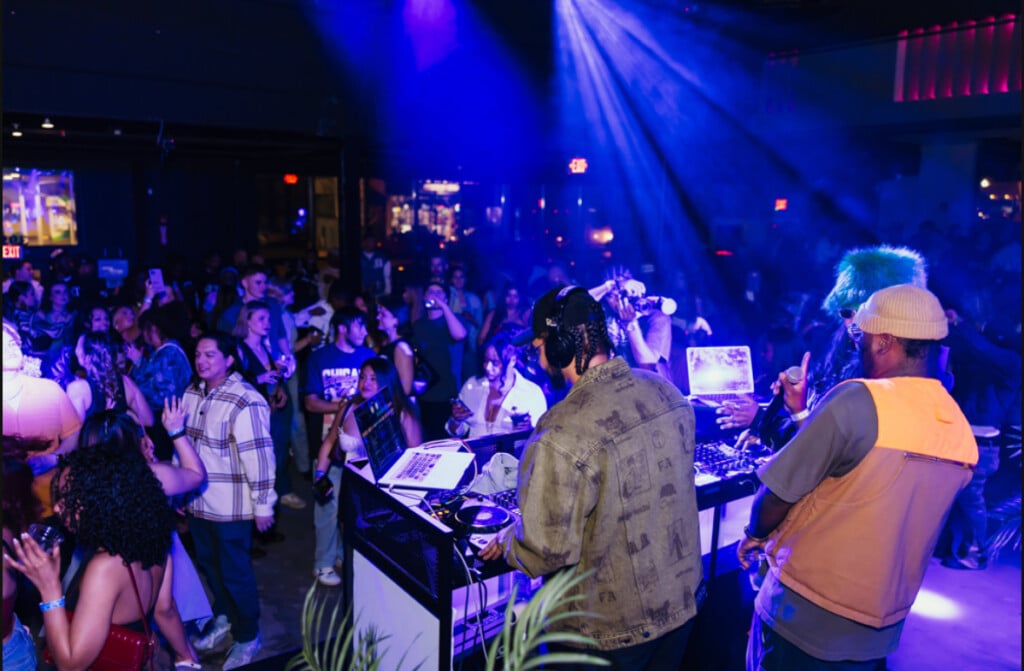Kevin McGraw reflects on First Friday’s origins and the artists that made the Crossroads their canvas
Just a few decades ago, Kansas City’s Crossroads district was coined by its near-empty stretch of streets, dotted by auto shops, empty buildings, and tumbleweeds rolling in the wind. The predominantly industrial area was desperate for a new purpose.
But that quiet space gave artists like Kevin McGraw, Jim Leedy, David Ford, and Tom Dethridge room to experiment—setting up studios, galleries, and small performances in unoccupied buildings. Their collective efforts, combined with building owners willing to take a chance on art, slowly brought life to the district.
First Friday emerged organically from these collaborations, with galleries and pop-up shows appearing each month; never just a single person’s vision, but a communal effort.
Today, First Friday draws thousands of visitors, showcasing street art, live music, and good eats, all while supporting emerging artists.
The Pitch sat down with McGraw, one of the many original hands involved in First Friday’s inception, where he shared that the most important legacy is opportunity: giving new artists a chance to show their work and helping the Crossroads remain a place where creativity and community thrive.
The Pitch: What was the spark that inspired an art festival in Kansas City?
Kevin McGraw: Well, we bought our building in 2001 at 1600 Locust, the old fire station, and there was nobody down there. The Sprint Center wasn’t there. Power & Light wasn’t there. The Kansas City Star building wasn’t there. I was just kind of a mid-career artist at that time, and Jim Leedy—who’s kind of the grandfather of the Crossroads—we were friends, and had been friends for a long time. The Leedy-Voulkos Art Center was a real thing, and he was a guy that was trying to build a community, and he wanted to supply and provide artists with studio space, basically. So he bought that huge building at 20th and Baltimore, and started putting studios in there.
Hugh Merrill was an artist and teacher at the Kansas City Art Institute, and Jim had been there many years at that point—he started in ’66—so I just kind of liked his vibe. And as an upcoming artist, I kind of needed studio space and wanted to work downtown. And at the time, we were living in Brookside, and I didn’t have a lot of money, so it wasn’t like an easy thing to have an additional studio space to work. So I worked in the basement of my house. It was dark, small, and tiny with low ceilings.
Jim was the guy. He started it. He started providing spaces for artists that were students at the Art Institute and other places. There were kids that weren’t students that just loved making art. There were just a lot of artists, but it was kind of like a ghost town. It was like there were literally tumbleweeds blowing around, and then there was nobody down here. There was no street activity. There were people that came to work, and then after work was over, it was a ghost town.
As it progressed—Susie Aron owned a lot of buildings down in the Crossroads. And Jim had amassed, by that time, several buildings. His studio space was over off Wyandotte. So I spent a lot of time at his studio. David Ford had a studio. STRETCH had a studio over on Wyandotte. I had just bought this building and was starting a gallery for local and young, upcoming artists that couldn’t get shows at the Blue Gallery, the Morgan Gallery, or some of the other fancier galleries.
It was very organic. Shows would pop up in office buildings that weren’t even occupied. They would get lights and plug extension cords in, and it was like this crazy, great, energetic time where it was just like, if you had work and you wanted to show it, we figured out a way to get that done.
How did all of those connections eventually pool into First Friday?
I think we started meeting—Susie Aron and some of the Crossroads building owners: John O’Brien and Brad Nicholson, Susie Aron, Margaret Silva—and people started kind of getting together and saying, “Okay, well, properties are changing. City code stuff. People are moving in, and we can’t just do it hodgepodge. It’s got to be sort of up to code, as it were.”
So we started—all of us, Tom Dethridge, David, me, Jim, and everybody—we just sort of said, “Hey, let’s try to not harness it or rein it in, but more like… let’s take advantage of it, and let’s kind of try to promote this area.”
I don’t know who decided it. Maybe it was STRETCH, because I know he was in the middle of starting Grinders. We just kind of decided—I don’t know who did, really—but it just started. It’s like, “Okay, first Friday of the month, we’re gonna have shows.” And there were shows outside on the streets, there were performing artists, there were all kinds of stuff that was happening; organic, fun, and music. I remember it being like, “Okay, now it’s First Friday, so we’re gonna start having shows.” So everyone would sort of dig in and create work, and we would just do it in different buildings all over that area.
It was kind of like, “Here it is,” and then all of a sudden, it just started getting huge. They went from two or three galleries to, like, sixty galleries in a year and a half, two years, and it just went nuts. It was awesome, because if you wanted to have a show, you could do it. You could do it in any number of places and people came down to see it. People started buying it. It just became this cool, fun place where there wasn’t any commercialized bullshit like McDonald’s or KFC. It was all just local people who owned buildings and tried to rent them out to local business owners.
When that started, it was like, “Okay, well, now we’ve got a really good infrastructure,” and then the galleries even got bigger. More businesses were participating in the art scene and taking advantage of the number of people coming down to see the work. Again, I don’t know who coined it, but First Friday started, and then it’s just been kind of gangbusters ever since.
It was clear that there was already an audience for it; it just needed someone to get the ball rolling. What were your initial hopes when it started?
Well, my hope was to sort of help carry the baton—hand it off from Jim—because building a community was his goal. And that’s sort of why I was like, “Alright, well, that’s why I had to buy down here.” I felt like, “Well, this guy has put his whole life into providing studio spaces for art and artists.”
I wanted to provide art places, or studio or gallery spaces, and teach kids who were up-and-coming, who were interested in doing art: “Hey man, here’s how you do it. Here’s how you do a show. You get an invitation. You get an invitation list. You promote it. You figure out how to do that. You get the art. You make sure you know how to hang it on the wall. You make sure that this is what you’re presenting. This is how you do a show.”
My hope was to invigorate and help push that idea of Let’s get some more kids involved in making art. And for the kids who are already making art, let’s give them a place to show it that doesn’t cost them anything.
What was one of the first major hurdles you guys needed to jump, and in that same vein, what was the first big victory you guys celebrated where you knew you had traction?
It was probably a couple years into it—probably 2004, 2005. Grinders had started, and it was doing well, and it had helped sort of solidify the East Side of the Crossroads into a viable place. Matt Abbott came in and bought a bunch of buildings and renovated them, and kept the feel and the art sort of vibe alive and continuing, while still providing great rental space for small businesses.
Kind of this whole cool collaboration of small-business building owners, artists, teachers just created this cool thing. I don’t think anyone really knew what it was going to be. It seemed like we were going in the same direction with it, and then it just exploded. The first big victory was literally, one First Friday, you look out and you see 20,000 people. It’s like, “Wow, here they are. This is unbelievable.”
It went kind of crazy nuts. And then you see all the apartment buildings and the office buildings and the living quarters. It’s amazing what has come in, what it’s turned into. I would have never imagined that then. But our goal was: “Let’s have an art show. Let’s get some kids involved. Let’s make it happen.” And we did. And then, I guess you can say, the corporate guys came in and really took it to the next level—in terms of all of these 20-story buildings down here.
This was an old automotive district, as most people know. This was all junkyards. All these little two-story buildings down in the Crossroads were machine shops, brake places, VW repair shops, muffler places. It was all this automotive stuff. There weren’t a lot of tall buildings. Now they’re everywhere, and they’re awesome, and they’re beautiful. The architecture and the art—it all seems to be like a big, cohesive thing. So if you say, “What did you hope?” Yeah, this is kind of what we hoped for. It’s the place to be. It’s a destination. You can enjoy art, great food, and great music.
After a couple of decades since you started, how would you describe how First Friday has developed?
I think it’s better. As I get older and see it—seeing it as a 30-year-old then, and now I’m 60—it’s been 30 years, really. A lot of change, and I think it’s fantastic. I really do. I think Kansas City is known for its vibrant art scene.
Boulevard was always part of that. John O’Brien was always generous. I remember back in the days, we called the I-beam bar outside of STRETCH’s place on Wyandotte. After work, we’d go sit on the I-beam bar, and John would bring a half-barrel of Boulevard Wheat or Pale Ale, and we would sit there and drink beer at the I-beam bar, 10 or 15 of us. A lot of energy going on, and it’s grown into this, and I think it is better. I think it’s ultimately because we’re known for it. It’s the Crossroads where it’s not just, “You can go see some paintings on a brick wall.” You’ve got music, you’ve got people dancing, performing, singing, and doing street art.
All the graffiti—they call graffiti—they’re doing all that wonderful stuff at Children’s Mercy, so lots of great artists have come out of this place, and Jim said it great that back in the ’70s, ’80s, artists would come to the Art Institute, and then they would go to New York, Chicago, or L.A. And then, they started staying here. Artists would start coming here from different places, so it became an art melting pot.
The frame shops were popping up—and of course Dolphin Frame that Scotty Gobber runs wonderfully now, that John O’Brien started—that was down on Baltimore, right next to Leedy-Voulkos way back in ’80s when they were having art shows just at the frame shop and it was fantastic. There’d be music, and there’d be Jim playing on his banjo, and it was just organic. Like, “Okay, well, Jim’s here, he’s just gonna pull out his banjo and start playing.”
The difference then and now? I think it is greater and bigger. And I think, whether any of us wished it was going to be big like it is now, or famous, or whatever you want to call it, I don’t know that that necessarily was the goal, but everyone’s passion was to make art, be involved in the art, and be a part of it.
What do you think the next evolution might look like 20 years or so from now?
I’d like to think that there’d be some more galleries, more concentrated galleries, and more affordable galleries, where you don’t see stuff that’s $15,000 or $20,000. You can go to a place and buy a piece for $300, $400, $500 and have it in your apartment or your house, and really appreciate it.
And just more education, more helping the kids coming up to know what the art world can be for them and for the future. Because, I mean, that’s where the artists are now. They’re in fourth, fifth, and sixth grade, and they’re coming up. There’s a place like Leedy-Voulkos where you can go and take art classes. There are lots of places around that you can do that. That never was around. I didn’t have that—I just sort of made art. I just want to see the kids grow, and I want to see great art happen.
You touched on it a little bit about art scenes in other cities, but are you hoping for First Friday–style events to pop up all over the country?
It makes sense here in a “cowpoke” town that we’ve always been called—It’s like, “Wow, in the middle of this shitty part of downtown where no one ever comes, this happened and it’s still happening.” So absolutely, I want to see it. And I can see it happen in Cincinnati, Pittsburgh, Cleveland, Tulsa, all over—absolutely. Austin—we all know the music scene in Austin that’s happened in the last 20 years, and it’s become a really great, incredible place.
I think a lot of the same stuff goes on. You see street vendors, and you see people making art on the side, traveling to those places and trying to sell their work. Like the Plaza Art Fair—only cooler. Not to knock the Plaza Art Fair, but I think it’s become a little cliquey. If you were on the list, then you had to have your stuff there. I think that was exactly what we didn’t want. It was, “Everyone’s welcome. Anyone can have a show. Let’s do it. Let’s have it out. And if it’s good enough to sell, then let’s put it up.”
What would you say to a group of artists looking to start their own festival somewhere else?
Totally go for it—100%. Try to think of the best way that’s not intrusive, that’s amicable for everybody—for the businesses involved, if there’s a business involved, having art on the wall. We all go to the hotels, hospitals, and places where you see shitty art everywhere. It’s some print from some bullshit thing that an artist didn’t even do—it’s just a print or a poster. Why can’t all that stuff be cool, original art?
One of the things, coming up as an artist for me, is seeing those spaces. I mean, I did a show in a laundromat in Lawrence on 9th Street, because there were all those big white walls, and they were screaming for something. They still have my art at that place today, which is so cool. There are all kinds of buildings and businesses that don’t have anything on the wall, and they should. Inside Out has been great, because you’ll see art on the outside of buildings now that you never would have seen before.
I would say to anyone who wants to do it, go full force. Get involved with the Chamber of Commerce in whatever town you’re in, and find out if people are looking for that stuff. Would it help their business? Would it help people get more aware of what they’re doing? It’s a collaboration. Artists don’t have to be separate. I mean, we all know what happened to SoHo in London and SoHo in New York: It was the shittiest, poorest towns, and then the artists moved in and made it cool. Then the coffee shop opens up, then the bookstore, and then the business guys show up and go, “Everyone’s here. Now let’s build our hotels, our condos.”
That’s exactly what’s happened. And that’s not necessarily a bad thing. The artists will always go to the next place. They always have. The West Bottoms was our crawl for a long time, and now the $400 million investment they’re doing down there—which is great—to a certain extent, I’d like to say artists helped develop that, helped get people aware of an area that could be really cool.
And then here’s the Crossroads. Look at it. If you look at the skyline—just as a medium skyline—if you went 20 feet in the air on a ladder and looked west from 71 Highway, it’s completely different, and it’s awesome. Look at Children’s Mercy. Even though they’ve been here a long time, look at the new improvement there. It’s great. They didn’t have to put that there. Maybe they put it here because the artists were here. But they’re involved in it, they’re showing art, and it’s great because they support it.
What kind of legacy do you want First Friday to leave on Kansas City? How do you want it to be remembered?
It just makes sense that it would be giving the small guy a chance. The little guy—the artist that would never show his stuff anywhere until a place like the Crossroads provided it. That was my message from the very beginning when we started having shows at the #8 Art Gallery. I don’t need to have shows of famous artists here—and I probably won’t—because I’m the #8 Art Gallery. No one knew who it was, where it was, or what. At the time, they had no idea.
But when I started having shows of kids from Lincoln Prep—grade school kids, high school kids—that were just coming up and not knowing anything about the art scene, about what to do, how to do a show, how to present your work… I want to see more of that. More people really knowing and learning, “Hey, this is how I spend studio time. This is how I spend time in the studio making my work.” You don’t have to be a studio artist to be a good artist; you just have to make the art. I want to make sure they’re excited about it and provide an opportunity for them to show it.
